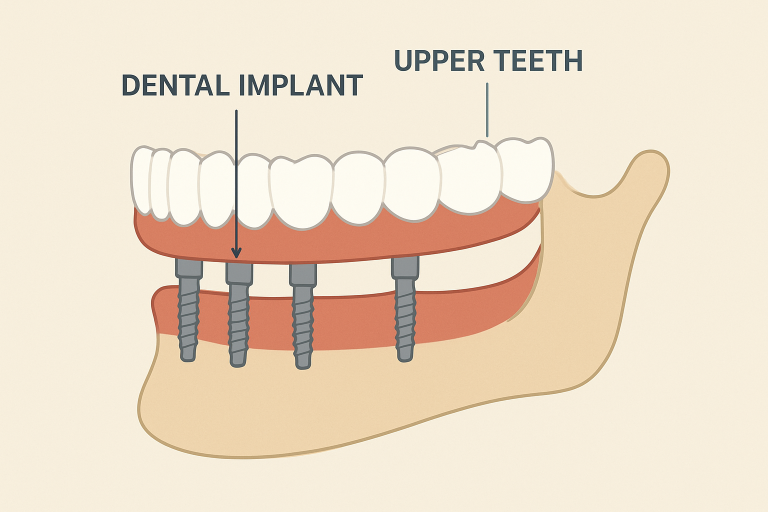Understanding All-on-4 Dental Implants
For patients with significant tooth loss or advanced dental decay, All-on-4 dental implants offer an innovative, highly effective solution. By using just four strategically placed titanium implants in areas of the jaw with optimal bone density, this method supports a fixed, natural-looking bridge that can restore an entire arch of teeth. This approach delivers impressive stability and function, offering a permanent alternative to removable dentures. Patients in metropolitan areas can learn more about availability from local experts, such as All On Four Dental Implants St Louis, MO.
The All-on-4 technique is designed to maximize the use of available jawbone, often eliminating the need for bone grafts that might be required with traditional implant approaches. By anchoring a complete set of prosthetic teeth to just four implants, dental professionals can transform smiles and oral function in a process that is less invasive and more cost-effective than placing a single implant for each missing tooth.
The All-on-4 method was developed to address the limitations associated with traditional dentures and individual implants, emphasizing immediate restoration and improved patient satisfaction.
One crucial factor is the placement of implants in the anterior maxilla (the front part of the upper jaw), where bone is typically denser, helping ensure the long-term success of the restoration.

Benefits of All-on-4 Implants
Immediate Functionality and Aesthetics
Unlike traditional implants that can require months of healing before new teeth are placed, All-on-4 implants allow most patients to walk out of the dental office with a provisional set of teeth on the same day as their surgery. This “teeth-in-a-day” approach means that individuals immediately regain the ability to chew, speak clearly, and smile confidently.
Bone Preservation and Long-Term Stability
Dental implants help preserve jawbone by transferring bite forces to the underlying bone, stimulating natural bone remodeling and preventing further bone loss. Avoiding the bone resorption that typically follows tooth extraction or loss is a significant benefit for maintaining facial structure over time.
Improved Quality of Life
Patients often report a dramatic improvement in their overall quality of life following All-on-4 restoration. The stability, comfort, and lifelike appearance of fixed teeth allow for a more diverse diet and easier oral care routines than removable dentures.
Potential Risks and Considerations
Although the All-on-4 technique boasts a high success rate, individuals should be informed of specific risks before pursuing this treatment. Maintaining excellent oral hygiene is essential to prevent peri-implant disease or infection around the implant sites. Proper post-operative care and regular dental visits are crucial for the longevity of dental implants.
- Risk of Infection: As with any surgery, there is a risk of bacterial infection during the healing period.
- Implant Failure: While rare, about 5% of cases may experience problems, often due to underlying health issues, poor bone quality, or improper care.
- Adjustment Period: Transitioning to a full-arch prosthesis can require a short period for speech and bite to adapt.
Maintenance and Oral Hygiene
Daily Care Essentials
Ongoing maintenance is the most critical factor for achieving the long-term success of All-on-4 dental implants. Patients should brush twice daily with a soft-bristle toothbrush and use tools such as a water flosser or interdental brushes to eliminate debris between the prosthetic teeth and gums. According to the CDC, following proper oral hygiene practices for adults, including regular brushing, flossing, and routine dental checkups, helps maintain healthy gums and prevent complications.
Professional Cleanings and Monitoring
Regular dental check-ups every six months allow for professional assessment and cleaning, increasing the chance of prompt detection and management of any emerging issues. Cleanings help address areas that are difficult to manage with home care alone and prevent the development of biofilm or plaque around implants.
Cost Considerations
The cost of All-on-4 dental implants varies depending on several factors, such as geographic location, the dental team’s expertise, and the materials used for the prosthesis. On average, the cost per arch can range from $15,000 to $28,000. Many dental practices offer flexible payment plans and financing solutions to help make this life-changing procedure more accessible. Patients should consult their dental provider for an individualized treatment plan and an accurate estimate.
Is All-on-4 Right for You?
Who is an Ideal Candidate?
- Individuals who have lost most or all teeth in a single arch.
- Those seeking a permanent, stable solution rather than removable dentures.
- Patients with enough healthy bone in the anterior maxilla, which can often be determined via dental imaging and consultation.
An in-depth evaluation with a qualified dental implant specialist is necessary to determine candidacy, taking into account oral health, bone quality, and overall medical history.
Conclusion
All-on-4 dental implants are transforming the lives of individuals seeking a stable, long-lasting alternative to traditional dentures and multiple individual implants. With careful planning, proper maintenance, and guidance from experienced dental professionals, patients can enjoy the confidence and functionality of a new smile for years to come. The first step is a personalized consultation to explore all available options and develop a treatment plan tailored to each individual’s unique needs.



